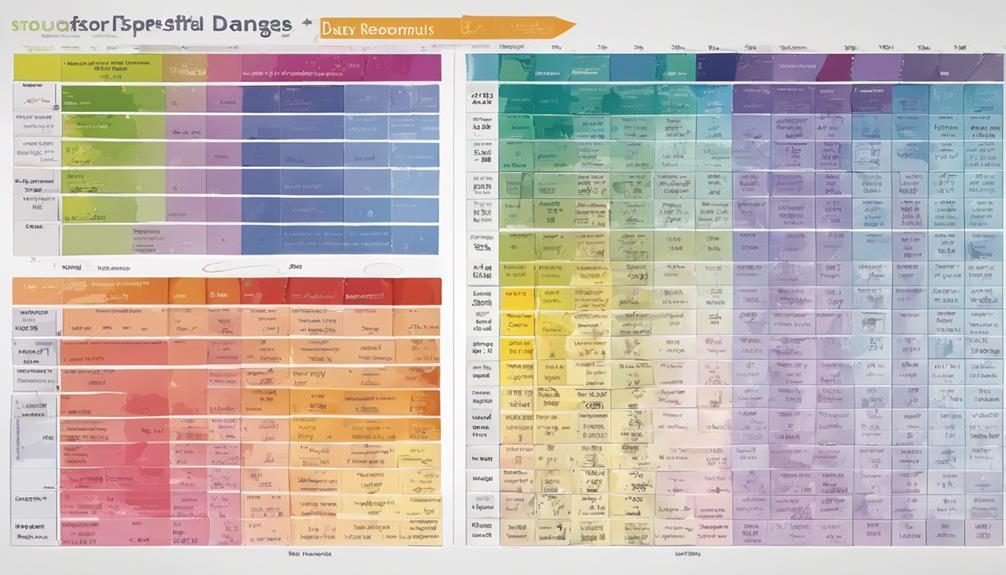Mixing breast milk with formula may seem daunting, but rest assured – it’s a feasible task that is worth exploring.
In our guide, we uncover the intricacies of combo feeding, offering valuable insights and practical tips for parents managing this feeding method. From switch advice to maintaining milk supply, we have you covered.
Stay tuned to discover how mastering combo feeding can be a rewarding experience for both you and your little one.
Key Takeaways
- Balancing breast milk and formula optimizes baby nutrition.
- Consistent milk removal is crucial for maintaining milk supply.
- Prioritize breast milk before formula for successful combo feeding.
- Seek guidance from professionals for tailored feeding routines.
Understanding Combination Feeding Basics
Understanding the basics of combination feeding involves balancing breast milk and formula to provide ideal nutrition for a baby's growth and development. Parents opt for combination feeding due to reasons such as low milk supply, the need to return to work, or involving other caregivers in feeding routines. This method allows for flexibility in nourishing the baby while addressing various feeding challenges that may arise.
Shifting to combination feeding requires establishing a full milk supply before introducing formula. Expressing milk regularly is essential to maintain milk supply when supplementing with formula. By offering both breast milk and formula in a bottle, caregivers can make certain that the baby receives adequate nutrition even if challenges like low milk supply occur. This approach gives parents the freedom to adapt to their circumstances while prioritizing the baby's nutritional needs.
Balancing breast milk and formula in combination feeding guarantees that the baby's requirements are met effectively.
Establishing Breast Milk Supply
To establish a robust breast milk supply for combination feeding, consistent milk removal 8-12 times per day is essential in the first 4-6 weeks after childbirth. Breast milk first is important for breastfeeding success, as milk production hinges on the frequency of milk removal.
Whether through nursing or pumping, ensuring sessions align with the baby's feeding times is key. Lactation consultants play a pivotal role in guiding mothers through any feeding issues that may arise and in maintaining the best milk supply.
It's advisable to consult with a healthcare provider to address concerns about milk production before introducing formula in combination feeding. Remember, the key to successful breastfeeding and milk supply maintenance lies in regular milk removal and seeking professional support when needed.
Managing Milk Supply for Combo Feeding
When managing milk supply for combination feeding, maintaining consistent milk removal is paramount to prevent a decrease in milk production. It is crucial to breastfeed or pump 7-8 times a day to guarantee an adequate milk supply when practicing combo feeding. Failure to sustain this consistency can lead to a decline in milk production, highlighting the importance of regular nursing sessions or pumping. Consulting with a lactation consultant can provide valuable support in addressing any feeding issues and guaranteeing proper milk production. Milk supply is directly linked to the frequency of milk removal, underscoring the necessity of nursing or pumping every time the baby feeds. Establishing a full milk supply generally takes 4-6 weeks with consistent milk removal 8-12 times per day when initiating combo feeding.
| Benefits of Consistent Milk Removal | Risks of Inconsistent Milk Removal |
|---|---|
| Prevents decrease in milk supply | Decline in milk production |
| Ensures proper milk production | Potential feeding issues |
| Maintains adequate milk supply | Risk of reduced milk supply |
| Supports combo feeding success | Compromised nursing experience |
| Enhances overall feeding experience | Disruption in feeding routine |
Implementing Combo Feeding Techniques

For successful implementation of combo feeding techniques, it's essential to prioritize offering breast milk before introducing formula based on breast milk intake.
Observing baby cues during feeds is vital in determining hunger and satiation levels.
When beginning on this feeding journey, remember there's no one-size-fits-all approach. Schedules and ratios should be tailored to your baby's unique needs, which may evolve over time.
Seeking guidance from a pediatrician for any feeding concerns and consulting a lactation consultant for specialized chestfeeding advice can provide valuable support and reassurance.
To guarantee a smooth change between breast and bottle, consider practicing paced bottle-feeding techniques. This method mimics the natural pace and rhythm of breastfeeding, promoting a comfortable feeding experience for your little one.
Ensuring Proper Storage and Feeding Practices
Proper storage and feeding practices for breast milk and formula mixtures are essential for maintaining quality and safety standards. It's important to store breast milk and formula separately to prevent contamination and guarantee freshness.
Follow specific guidelines for storage to uphold hygiene standards and avoid bacterial growth. Dispose of any unused mixed milk and formula promptly, within an hour of feeding, to prevent potential risks.
Adhere to formula storage recommendations to guarantee the quality of the mixture. When serving the mixed milk and formula, make sure it's at the desired temperature, whether cold or warm, based on the baby's preference.
Frequently Asked Questions
How Do You Combo Feed With Breastmilk and Formula?
We combine breastmilk and formula by offering breastmilk first, then formula, maintaining a consistent routine for baby's adjustment. Watching hunger cues and feeding until full is essential. Healthcare pros can offer guidance on successful combo feeding practices.
Is It OK to Formula Feed and Breastfeed at the Same Time?
Yes, it's safe and beneficial to breastfeed and formula feed simultaneously. Mixing breast milk and formula can offer a variety of advantages. Always seek guidance from a pediatrician for the best approach.
How Should You Mix Formula and Breastmilk?
We typically mix formula and breastmilk by feeding them separately. It's important to consult with a pediatrician to determine the best approach for your baby's needs. Keeping breast milk and powdered formula feedings separate is generally recommended.
How Do You Alternate Between Breastmilk and Formula?
We alternate between breastmilk and formula by evaluating baby's needs, caregiver availability, and personal preferences. Balancing feeds guarantees essential nutrients. Consistency in this routine establishes a feeding schedule. It's a balancing act that keeps everyone happy and healthy.
Conclusion
In mastering the art of blend feeding, we've discovered the perfect blend of nourishment for our little ones.
Just like a delicate dance between two partners, combining breast milk and formula creates a harmonious symphony of love and care for our babies.
Let's continue to embrace this journey with confidence and grace, knowing that we're providing the best of both worlds for our precious bundles of joy.










